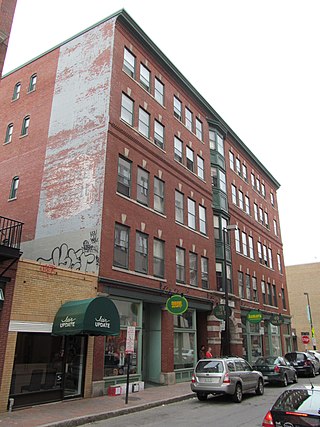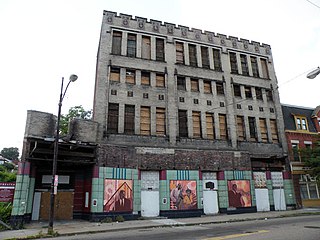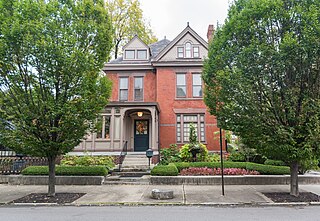
Cabell Calloway III was an American jazz singer and bandleader. He was a regular performer at the Cotton Club in Harlem, where he became a popular vocalist of the swing era. His niche of mixing jazz and vaudeville won him acclaim during a career that spanned over 65 years.
Old Orchard Beach is a resort town in York County, Maine, United States. The population was 8,960 at the 2020 census. It is part of the Portland−South Portland−Biddeford, Maine Metropolitan Statistical Area.

The Cotton Club was a New York City nightclub from 1923 to 1940. It was located on 142nd Street and Lenox Avenue (1923–1936), then briefly in the midtown Theater District (1936–1940). The club operated during the United States' era of Prohibition and Jim Crow era racial segregation. Black people initially could not patronize the Cotton Club, but the venue featured many of the most popular black entertainers of the era, including musicians Fletcher Henderson, Duke Ellington, Jimmie Lunceford, Chick Webb, Louis Armstrong, Count Basie, Fats Waller, Willie Bryant; vocalists Adelaide Hall, Ethel Waters, Cab Calloway, Bessie Smith, Lillie Delk Christian, Aida Ward, Avon Long, the Dandridge Sisters, the Will Vodery choir, The Mills Brothers, Nina Mae McKinney, Billie Holiday, Midge Williams, Lena Horne, and dancers such as Katherine Dunham, Bill Robinson, The Nicholas Brothers, Charles 'Honi' Coles, Leonard Reed, Stepin Fetchit, the Berry Brothers, The Four Step Brothers, Jeni Le Gon and Earl Snakehips Tucker.

The Attucks Theatre is an historic theatre located in Norfolk, Virginia. The theatre was financed, designed and constructed by African American entrepreneurs in 1919, and was designed by Harvey Johnson, an African-American architect. The theatre was named in honor of Crispus Attucks, an African American who was the first patriot to lose his life in the Revolutionary War. When it was first opened, Attucks Theatre was known as the "Apollo Theatre of the South". The theater has hosted numerous famous entertainers throughout the early-to-mid-20th century, including Duke Ellington, Cab Calloway, Ella Fitzgerald, Red Foxx, and Louis Armstrong, as well as local stars such as Norfolk's Gary U.S. Bonds and Portsmouth's Ruth Brown.

The Wells'Built Hotel is a historic hotel that is now an African-American museum. It is located in Orlando, Florida, in the center of Orlando's historic Parramore district, at 511 West South Street. Dr. William Monroe Wells built the hotel, and a nearby entertainment venue, for African Americans visiting Orlando. During the segregation era, this hotel served as host to several now-famous African-American performers. On February 4, 2000, it was added to the U.S. National Register of Historic Places.

The Jackson Rooming House, also known as Jackson House, is a historic building constructed in 1901 as a boarding house in the city of Tampa, in the U.S. state of Florida. It provided accommodations to African-Americans and other travelers of African descent during the era of racial segregation. It is located on the north end of downtown at 851 Zack Street, approximately one block west of Tampa Union Station. On March 7, 2007, it was added to the U.S. National Register of Historic Places (NRHP).

The Jewell Building is a city landmark in North Omaha, Nebraska. Built in 1923, it is listed on the National Register of Historic Places. Located at 2221 North 24th Street, the building was home to the Dreamland Ballroom for more than 40 years, and featured performances by many touring jazz and blues legends, including Duke Ellington, Count Basie, Louis Armstrong, Dizzy Gillespie, and Lionel Hampton.

The Dunbar Hotel, originally known as the Hotel Somerville, was the focal point of the Central Avenue African-American community in Los Angeles, California, during the 1930s and 1940s. Built in 1928 by John Alexander Somerville, it was known for its first year as the Hotel Somerville. Upon its opening, it hosted the first national convention of the National Association for the Advancement of Colored People (NAACP) to be held in the western United States. In 1930, the hotel was renamed the Dunbar, and it became the most prestigious hotel in LA's African-American community. In the early 1930s, a nightclub opened at the Dunbar, and it became the center of the Central Avenue jazz scene in the 1930s and 1940s. The Dunbar hosted Duke Ellington, Cab Calloway, Billie Holiday, Louis Armstrong, Lionel Hampton, Count Basie, Lena Horne, and many other jazz legends. Other noteworthy people who stayed at the Dunbar include W. E. B. Du Bois, Joe Louis, Ray Charles, and Thurgood Marshall. Former heavyweight champion Jack Johnson also ran a nightclub at the Dunbar in the 1930s.

Winks Panorama, also known as Winks Lodge, was a hotel near Pinecliffe, Colorado catering to African-American tourists during the early and middle 20th century. The lodge was built in the Lincoln Hills Country Club, which was at the time the only African-American resort in the western United States. The Lincoln Hills club was organized in 1922, selling lots with payments as low as $5.00 down and $5.00 per month. The lodge was built by Obrey Wendell "Winks" Hamlet in 1928. Hamlet had been involved in the original club project, and had been assembling land for a lodge since 1925. The Wall Street Crash of 1929 caused many lots in Lincoln Hills to be abandoned, but Hamlet promoted the lodge nationally through advertisements in Ebony and attracted a clientele from the eastern United States.
Chronological Classics was a French compact disc reissue label. Gilles Pétard, the original owner, intended to release the complete master takes of all jazz and swing recordings that were issued on 78 rpm. By the time the label suspended operations in July 2008, its scope had extended to LPs.

The Martin Luther King Jr. Performing and Cultural Arts Complex is a historic building in the King-Lincoln Bronzeville neighborhood of Columbus, Ohio. It was built in 1925 as the Pythian Temple and James Pythian Theater, and was added to the National Register of Historic Places and Columbus Register of Historic Properties in 1983. The building was renovated into the King Arts Complex in 1987, and was vacated in 2019. Community leaders restored the building's use as an arts center in 2021.

The Staples Inn, now the Old Orchard Beach Inn, is an historic travelers' accommodation at 8 Portland Avenue in Old Orchard Beach, Maine. Located in a building dating to the late 18th century, it is the oldest known property to have regularly had summer boarders, with a documented history of doing so dating to 1840. The building was listed on the National Register of Historic Places in 1987.

The Everett Chambers or Hotel Everett is a historic mixed-use commercial and residential building at 47-55 Oak Street in Downtown Portland, Maine. Built in 1902 to a design by local architect Frederick Tompson, it is an important surviving example of a lodging house, built early in the transition period from the 19th century boarding house to more modern 20th-century transient accommodations. It was added to the National Register of Historic Places in 2004.

The New Granada Theater, which is located at 2007 Centre Avenue in the Hill District neighborhood of Pittsburgh, Pennsylvania, was built between 1927 and 1928.

The Whitelaw Hotel is an historic structure located in the U Street Corridor in Northwest Washington, D.C. It was listed on the National Register of Historic Places in 1993.

The Riviera is a marina and mixed-use meeting hall at the shore of Geneva Lake in Lake Geneva, Wisconsin, United States. Riviera Beach is an adjacent daily admission beach.

Rock Rest is a historic house and African-American traveler's accommodation at 167 Brave Boat Harbor Road in Kittery, Maine. The property was operated as a summer guest house by Clayton and Hazel Sinclair between 1946 and 1977, and is one of the few known places in Maine that explicitly welcomed African-American guests in an era when racial discrimination in public accommodations was common. The property was listed on the National Register of Historic Places in 2008.
The Manse Hotel is a historic place and former hotel in Walnut Hills, Cincinnati, Ohio which was important to the American civil rights movement. The hotel accommodated African American people and events during a time when African Americans were not allowed to stay in other Downtown hotels because of racial segregation. It was listed in The Negro Motorist Green Book from the 1940s through the 1960s and along with the Manse Hotel Annex has been listed on the National Register of Historic Places since August 8, 2019.

The Dr. Lewis M. Early Residence is a historic property in the King-Lincoln Bronzeville neighborhood of Columbus, Ohio. The house and office were listed on the Columbus Register of Historic Properties in 1984.


















